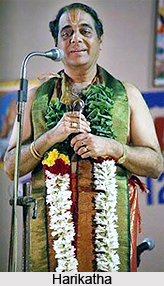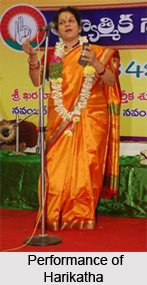 Harikatha is a composite art form comprising of story telling, poetry, music, drama, dance, and philosophy. Harikatha, strictly to sing of Hari or Vishnu, but in practice, all Hindu deities now form subject material. Harikatha is a well-defined art form presenting a story or charitram (character) in a given order, with certain songs and musical forms sung at particular places, interspersed with scriptural quotations. The songs may be in Sanskrit, Tamil, Marathi, Telegu, Hindi, or any other regional language.
Harikatha is a composite art form comprising of story telling, poetry, music, drama, dance, and philosophy. Harikatha, strictly to sing of Hari or Vishnu, but in practice, all Hindu deities now form subject material. Harikatha is a well-defined art form presenting a story or charitram (character) in a given order, with certain songs and musical forms sung at particular places, interspersed with scriptural quotations. The songs may be in Sanskrit, Tamil, Marathi, Telegu, Hindi, or any other regional language.
Harikatha commences with an invocation and the singing of God`s name. This introductory part of a katha also contains a brief statement of the underlying philosophy of the main story or of some general philosophical truth or truths. The second part, which is the main body, is the story itself. Included in the discourse are namasankirtan or song responses where the audience may participate.
Storyteller of Harikatha
The storyteller is called a Haridasu i.e. `Hari`s servant` or Bhagavatar i.e. worshipper. His outfit represents the ideal Vaishnava`s image i.e. a silk dhoti with a coloured waistband but no upper garment. He displays the Vaishnava V-shaped religious mark on forehead, forearms, and chest, with a garland of flowers round his neck. He holds only one instrument, the chirutalu, a small pair of clappers, while gajjelu or anklets on his feet accompany his delicate dance. Sometimes mridanga drum and, of late, a violin or harmonium play at more formal concerts mostly patronized by the Brahmanic upper and middle-class landowning communities. Any Hindu religious theme may be the subject for the Harikatha. During its peak, Harikatha was a popular medium of entertainment, which helped transmit cultural, educational and religious values to the masses.
Harikatha in Viravaishnava Times
Harikatha was created during Viravaishnava times i.e. sixteenth or seventeenth centuries. This was created as a form of door-to-door Vaishnava campaigning, originally performed by Chathadi Vaishnavas or Sathanis and Dasaris, both non-Brahmanic priesthoods and propagators. This piecemeal singing of Hari`s myths in the third person, to punctuated shouts of ecstasy addressed to Hari like Harilo ranga Hari! and Srimad Rama Ramana Govindo Hari!, encouraged the audience to repeat the chant as an echo or chorus. Much later, it was given concert form at individual households on invitation for a payment. Such seated concerts became known as Katha Kalakshepam throughout south India.
 Harikatha in Andhra Pradesh
Harikatha in Andhra Pradesh
In Andhra Pradesh, Harikatha is closely related to the Abhang tradition of Maharashtra owing to the popular cult of Pandarinath. Thus, its Telugu literary form is full of dobaras or couplets, taharas or triplets, and lavanis i.e. used in Tamasha, apart from pure Telugu metres like kandam and kandartham from Yakshaganam.
Contemporary Harikatha
Contemporary Harikatha starts with a regular Sanskrit prayer, the Suklambaradhararn, and one or two prayers in Telugu. Then, in stylized prose, the evening`s subject is revealed. The story always began in dam metre, now substituted by any metre that comes in handy, including cinematic song. The main narrative remains sung, with prose insertions to link up the story or to introduce a digression. The most populist aspect is the comic improvisation breaking the narrative. This `alienation` provides space for sharp wit and sarcasm by making the topic contemporary, relating it to present-day socio-political situations, but the opportunity is misused nowadays, replacing the finer elements with crude filmic comedy.
People Famous for Harikatha
Adibhatla Narayanadas (during the years 1864-1945), the so-called `grandfather` of concert Harikatha in Andhra was a self-taught Brahman writer-performer. He confessed in his autobiography that he did not learn from any guru, but was influenced by the performance of a famous Haridasu of his childhood. His name was Kuppuswamy Naidu, in Vizianagaram. Naidu was a natural singer, he created his own Harikatha, picking up darns from the Yakshaganam titled Dhruvacharita i.e. `Dhruva`s Story`. Some padyams or verses from Potana`s Bhagavatatn, a few pitta kathalu from Hitopadesa, and even tales from English literature that he read. He tested his performing ability with this concoction before his elder brothers, then at the Venugopala Temple, and admitted that whatever he sang and danced was accepted, evidently because of his own style and personal charisma. His virtues of improvisation and liberal use of digressions diluted the textual strength but now survive as the modern form. His twelve scripts became a model for countless followers; famous among them are Pasumarthi Krishnamurthy, Neti Lakshminarayana, and Vajapayala Venkata Subbaiah.
Among Narayanadas`s contemporaries, Balajidas of Anakapalle in Visakhapatnam district and Chevuri Erukayyadas of Bobbili in Vizianagaram district were respected for their classical qualities. Balajidas tasted fame for improving Harikatha dance with his scholarship in the Natyasastra and Erukayyadas for contributing to the music.
Other notable early practitioners included Panyam Sitarama Bhagavatar, Prayaga Sangaiah, and Koduru Bhogalingadas. Later disciples of Narayanadas are Kota Sachidananda Sastry, Tellakula Venkateswara Gupta, Kuchibhotla Koteswar Rao, and Akkipeddi Srirama Sharma.
After Independence, middle-class women also mastered the art, such as Bejavada Nagaraja Kumari and R. Durgamba. The reputed music school in Tirupati runs an exclusive course in Harikatha, as the form is demanded during the festive days of Dussehra and Ganesh Chaturthi.
The original lower-caste Harikatha, which converted a whole range of less privileged communities to Vaishnavism, is now reduced to mere begging, by a few itinerant Sathani singers.




